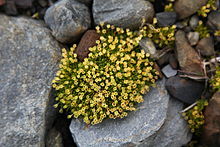Colobanthus quitensis
| Colobanthus quitensis | |
|---|---|

| |
| Antarctic pearlwort at St. Andrews Bay, South Georgia Island | |
| Scientific classification | |
| Kingdom: | Plantae |
| Clade: | Tracheophytes |
| Clade: | Angiosperms |
| Clade: | Eudicots |
| Order: | Caryophyllales |
| Family: | Caryophyllaceae |
| Genus: | Colobanthus |
| Species: | C. quitensis
|
| Binomial name | |
| Colobanthus quitensis | |
| Synonyms[1] | |
| |
Colobanthus quitensis, also known as the Antarctic pearlwort, is one of two native flowering plants found in the Antarctic region.[2] It has yellow flowers and grows about 5 centimetres (2 inches) tall, giving it a moss-like appearance. Due to climate change, the species has been spreading rapidly, particularly to areas outside of Antarctica.[3]
Description
[edit]
Colobanthus quitensis has yellow flowers and grows about 5 centimetres (2 inches) tall, with a cushion-like growth habit that gives it a moss-like appearance. It is an angiosperm, meaning that it is a plant that produces flowers, and is capable of asexual reproduction.[4] It relies on wind pollination because of the lack of bees and other pollinating insects in the Antarctic region.[2] Although it is moss-like, Colobanthus quitensis is a tracheophyte, or vascular plant, meaning that it contains vascular tissues called the phloem and xylem.[5]
Symbiosis
[edit]Endophytic fungi have been found living inside of the leaves of Colobanthus quitensis, including saprobic and pathogenic fungal species. Research studies have shown that these fungi are able to produce melanin in their hyphae, which may be the reason they are able to withstand freezing temperatures.[6] The presence of these endophytic fungi have been shown to increase plant performance.[7]
Distribution
[edit]Colobanthus quitensis is found on the west coast of the Antarctic Peninsula, on South Georgia, South Shetland, the Falklands, and the Andes, becoming increasingly rare northwards, but reaching Bolivia, Peru, and Ecuador, with a further isolated population in Mexico.[8] It is one of two flowering plants native to Antarctica, the other being Deschampsia antarctica.[9]
Climate change
[edit]
Within Antarctica, due to climate change, more seeds are germinating, creating a large number of seedlings and plants. Reports indicate a fivefold increase in these plants, which have extended their ranges southward and cover more extensive areas. Research found that the Antarctic pearlwort spread nearly ten times faster during the period 2009 through 2018 compared to between 1960 and 2009.[9] Although future climate change may relieve environmental stress and increase the plants ability to photosynthesize, warming may reduce the plants ability to resist freezing temperatures.[3] These plants are most vulnerable during the Spring season when the Antarctic ice melts.[10] Furthermore, due to regional warming and human activity, non-native Antarctic species may colonize Antarctica and make it more difficult for native species to survive.[11]
References
[edit]- ^ a b "Colobanthus quitensis (Kunth) Bartl". Plants of the World Online. Royal Botanic Gardens, Kew. Retrieved 27 January 2020.
- ^ a b Kozeretska, Iryna (2005). "The Herbarium of Antarctic Vascular Plants". National Taras Shevchenko University of Kyiv. Retrieved 9 February 2015.
- ^ a b Acuña-Rodríguez, Ian S.; Torres-Díaz, Cristian; Hereme, Rasme; Molina-Montenegro, Marco A. (2017-09-18). "Asymmetric responses to simulated global warming by populations of Colobanthus quitensis along a latitudinal gradient". PeerJ. 5: e3718. doi:10.7717/peerj.3718. ISSN 2167-8359. PMC 5607920. PMID 28948096.
- ^ Gianoli, Ernesto; Inostroza, Patricia; Zúñiga-Feest, Alejandra; Reyes-Díaz, Marjorie; Cavieres, Lohengrin A.; Bravo, León A.; Corcuera, Luis J. (2004-11-01). "Ecotypic Differentiation in Morphology and Cold Resistance in Populations of Colobanthus quitensis (Caryophyllaceae) from the Andes of Central Chile and the Maritime Antarctic". Arctic, Antarctic, and Alpine Research. 36 (4): 484–489. doi:10.1657/1523-0430(2004)036[0484:edimac]2.0.co;2#d1e162 (inactive 7 December 2024). ISSN 1523-0430.
{{cite journal}}: CS1 maint: DOI inactive as of December 2024 (link) - ^ Rudolph, E. D. (Apr 1965). "Antarctic Lichens and Vascular Plants: Their Significance". BioScience. 15 (4). American Institute of Biological Sciences: 285–287. doi:10.2307/1293425. JSTOR 1293425.
- ^ academic.oup.com https://academic.oup.com/femsec/article/73/1/178/645451. Retrieved 2024-12-06.
{{cite web}}: Missing or empty|title=(help) - ^ Torres-Diaz, Cristian, et al. "Biological interactions and simulated climate change modulates the ecophysiological performance of Colobanthus quitensis in the Antarctic ecosystem." PLoS One 11.10 (2016): e0164844.
- ^ "COLOBANTHUS QUITENSIS (Kunth) Bartl | BOTANY.cz" (in Czech). 2021-04-17. Retrieved 2024-11-25.
- ^ a b Singh, Geetika (2023-10-05). "Climate Change in Antarctica Has Given Rise to Blooming Flowers". Earth.Org. Retrieved 2024-11-16.
- ^ Edwards, J. A., and Ronald IL Smith. "Photosynthesis and respiration of Colobanthus quitensis and Deschampsia antarctica from the maritime Antarctic." British Antarctic Survey Bulletin 81 (1988): 43-63.
- ^ Molina-Montenegro, Marco A.; Carrasco-Urra, Fernando; Rodrigo, Cristian; Convey, Peter; Valladares, Fernando; Gianoli, Ernesto (2012). "Occurrence of the Non-Native Annual Bluegrass on the Antarctic Mainland and Its Negative Effects on Native Plants". Conservation Biology. 26 (4): 717–723. Bibcode:2012ConBi..26..717M. doi:10.1111/j.1523-1739.2012.01865.x. ISSN 1523-1739. PMID 22624790.
External links
[edit] Media related to Colobanthus quitensis at Wikimedia Commons
Media related to Colobanthus quitensis at Wikimedia Commons Data related to Colobanthus quitensis at Wikispecies
Data related to Colobanthus quitensis at Wikispecies- British Antarctic Survey - Plants
- Pearlwort & Hairgrass picture
